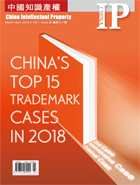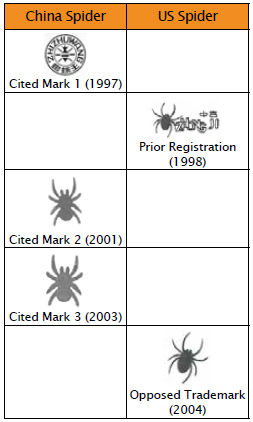CASE 3:
SPIDER KING’S TRADEMARK DISPUTE
◆ First instance: (2014) YiZhongZhiXingChuZi No. 4067
◆ Second instance: (2016) JingXingZhong No. 4490
◆ Retrial: (2017) ZuiGaoFaXingShen No. 3297
Beijing Municipal
[Headnotes]
The SPC expounds in its decision the difference between the extension of goodwill and that of trademarks. The goodwill built up by a market player in the course of business operation, may be, in a certain manner, shifted among or extended to a variety of carriers such as the trade name, trademark, packaging and decoration of goods of such market player, or any other signs that may serve as the source identifier of its goods or services. But the SPC categorically denied the extension of a trademark (other than that through trademark renewal): other than trademark renewal, Article 38 of the Trademark Law provides NO alternative form of trademark extension.
[Synopsis]
Plaintiff: Spider King Group Co., Ltd.
Defendant: the Trademark Review and Adjudication Board (TRAB)
Third Party: VSA Spider Group Limited
China’s Supreme People’s Court (SPC) reaffirmed in a recent Gazette case, Spider King Group Co., Ltd. v. TRAB and USA Spider Group Limited that, the reputation built up on a prior mark may extend to a later mark by the same applicant, but categorically denied the extension of trademark registration, except through registration renewal.
Spider King Group (China Spider) is a major footwear maker and the owner of three registered trademarks in class 25 in China—Cited Mark 1 registered in 1997, Cited Mark 2 in 2001, and Cited Mark 3 in 2003.
However, before Cited Mark 2 registered by China Spider, a USA Spider King Group Limited had registered another spider device in China in 1998. The trademark (Prior Registration), which is the combination of a spider device, Chinese characters “ 中吉” and its pinyin “ZHONGJI", was registered in class 25, designating baby clothes, shoes, swimsuits, etc.
On October 15, 2004, USA Spider King Group Limited applied for the registration in class 25 of the same device mark alone (Opposed Trademark), without the Chinese characters and Pinyin. The application was later assigned to US Spider Group Limited (US Spider).
On November 28, 2008, citing its three previous registrations, China Spider filed against the applied trademark an opposition, which was dismissed by the China Trademark Office.
On January 30, 2011, China Spider appealed to the Trademark Review and Adjudication Board (TRAB). US Spider argued that its prior registration in class 25 has being coexisting with the cited marks, and that there had been no evidence of confusion in the market.
The TRAB upheld the Trademark Office of National Intellectual Property Adminstration (CTMO) decision on September 10, 2012, finding that the trademarks in conflict were not similar and that the prior registration of US Spider justified the registrability of the Opposed Trademark.
China Spider appealed to Beijing No. 1 Intermediate People’s Court, on December 30, 2015, overruled the TRAB decision, based on similarity between the Opposed Trademark and the Cited Marks 2 and 3.
The TRAB and US Spider appealed to the Beijing High People’s Court, which dismissed the appeal on December 28, 2016. The Court found that the Opposed Trademark and the Cited Marks 2 and 3 are similar, and that the co-existence of the prior registration of US Spider and the Cited Marks cannot justify the registration of the Opposed Trademark.
US Spider filed a retrial application with the SPC, arguing that the Opposed Trademark was an “extension” of its earlier registration. On December 22, 2017, the SPC dismissed the retrial application, echoing the similarity finding of the lower courts.
In response to the “extension” of its earlier registration propoesd by US Spider in the retrial procedure, the SPC distinguished the extension of reputation and the extension of trademark.
Regarding the extension of reputation, the SPC affirmed that “The reputation built up by a market player in the course of business operation, may be, in a certain manner, shifted among or extended to a variety of carriers such as the trade name, trademark, packaging and decoration of goods of such market player, or any other signs that may serve as the source identifier of its goods or services.”
But in this case, where US spider needs to register a new trademark that is associated with a prior registered trademark, pursuant to Article 20, 21 and 22 of Trademark Law 2001, it is necessary to file a new application with the trademark administrative department, which shall review such application, no matter whether the prior registered trademark has built up a certain reputation, or how the goods designated by the new trademark relate with that of the prior trademark, or what the relationship between the two marks is. The registrability of the Opposed Trademark should be reassessed, rather than being justified by its association with a prior registration. Other than trademark renewal, Article 38 of the Trademark Law provides no alternative form of trademark extension.
[Judge's Comment]
Extension of trademark registration, a concept that had been widely discussed and invoked in China’s trademark practice, now becomes obsolete. The SPC is believed to be taking a tough stance against the practice, where applicants attempt to exploit prior registration in boosting the chance of registrability of a later similar trademark, which complicates the trademark prosecution procedure.
Nevertheless, the SPC acknowledges that reputation built up on a prior registration may be extended, but this continue conditionally. Given that the USA Spider merely insisted, in the retrial procedure, the argument on extension of trademark registration, the SPC was not obligated to assess whether extension of reputation is a viable argument.
In fact, the court of appeal did ascertain that this case does not fit the parameters as set by the SPC in an earlier decision, Bonneterie Cevensole SARL v. TRAB & Foshan Mingshi Industrial Co., Ltd. on the extension of reputation: (1) the prior registered trademark has accumulated certain reputation; (2) the later opposed trademark is identical with or similar to the prior registered trademark; (3) the designated goods of the later opposed trademark and that of the prior registered trademark are identical or similar; and (4) the public tends to associate the applicant’s later trademark with its prior trademark and to construe that the goods to which the later trademark and the prior trademark are attached originate from such applicant or are linked to the applicant, rather than associating the later trademark with the prior registered trademarks of other trademark owners.





